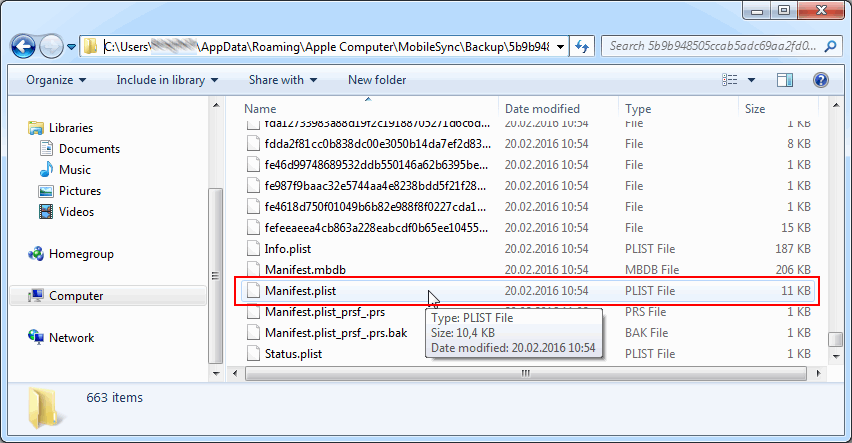What can Passcovery Suite do with iPhone and iPad passwords?
The recent buzz regarding iPhone personal data security generated a wave of requests about Passcovery’s ability to crack iPhone and iPad passwords.
Well, with Passcovery Suite you can recover passwords to user data backup files, but you cannot crack iPhone or iPad. The mechanism is as follows.
The demo is available for free download on the website:
Passcovery Suite 3.2 Download x86
(15600 Kb)Download x64
(17696 Kb)
Recovering iPhone and iPad passwords in Passcovery Suite
The only thing you need to attack the device is just one file – manifest.plist from the backup copy files located locally on your computer:

You don’t need the device itself, only the backup file. In Windows the backup copy is stored at
C:\Users\(username)\AppData\Roaming\Apple Computer\MobileSync\Backup\
So, if you have access to the computer the backup copy was made at, you already have everything to quickly recover the password. However, if the backup copy was made using iCloud, you should get the file first before using Passcovery Suite cracking capabilities.
Here is a tutorial on creating a local backup copy from iTunes/iCloud.
Why recovering a backup data password?
Basically, without it, your backup data are useless. You cannot restore data without knowing the password. Not a rare circumstance, in fact. This is where Passcovery Suite comes to the rescue.
The app is optimized for maximum performance on all modern CPUs and direct the entire computation power to password cracking. Moreover, Passcovery uses AMD and NVIDIA GPU capabilities for even more exhilarating password cracking performance.
As a result, Passcovery Suite is capable of restoring Apple iOS 6.x-9.x passwords way faster than many other tools.
Here is a comparison table for Intel® Core™ i7-2630QM, AMD Radeon HD 6770M, Windows 7:
| Passcovery Suite, 3.20 | ~8500-8900pps |
| Passware Forensic Kit, 2016.1.2 | ~3800pps |
| Tenorshare, 3.3.0.1 | ~600-700pps |
| Phone Breaker, 5.20 | -pps (We couldn’t evaluate performance in the demo version. Also, the app couldn’t find our graphics card) |
Of course, the absolute values aren’t exactly outstanding – the security of iPhone and iPad is high and passwords cannot be cracked quickly. This is a price you pay for secure protection of your personal data.
Cracking a strong password with a brute force attack only is virtually impossible. That is why Passcovery Suite features a number of methods to reduce the amount of generated passwords by adjusting the password range:
- Position mask. It helps when you know something about the password, like: the first symbol is a number, the second is a number or a vowel, then we have letters and some capital letters in the end
- Dictionary mutation. You can use up to 4 dictionaries simultaneously and mix words from them in one password
These videos explain how to do raise the efficiency of iPhone password cracking using dictionary mutation
How to mutate and multiply dictionary passwords
How to use words from multiple dictionaries
And here is a general tutorial on cracking any passwords using Passcovery Suite:
iPhone/iPad backup password recovery with Passcovery Suite
Adherence to security principles or... a brilliant PR campaign?
Apple has been in the top headlines for a long time. The campaign portrayed Apple as a bastion of security and privacy protection, but who knows how far from truth this is?
Apple says they don’t want to set a precedent and create a backdoor for a phone, as this would possibly lead to data leaks on many other iPhones all over the world. Yet they don’t deny creating such a backdoor is possible. Which means the system does allow backdoors.
Apple says iCloud is a totally secure place to store user data, but the storage format and security standards are proprietary, so you simply don’t know if this is true…
And of course, who knows how the data are protected from the company itself…